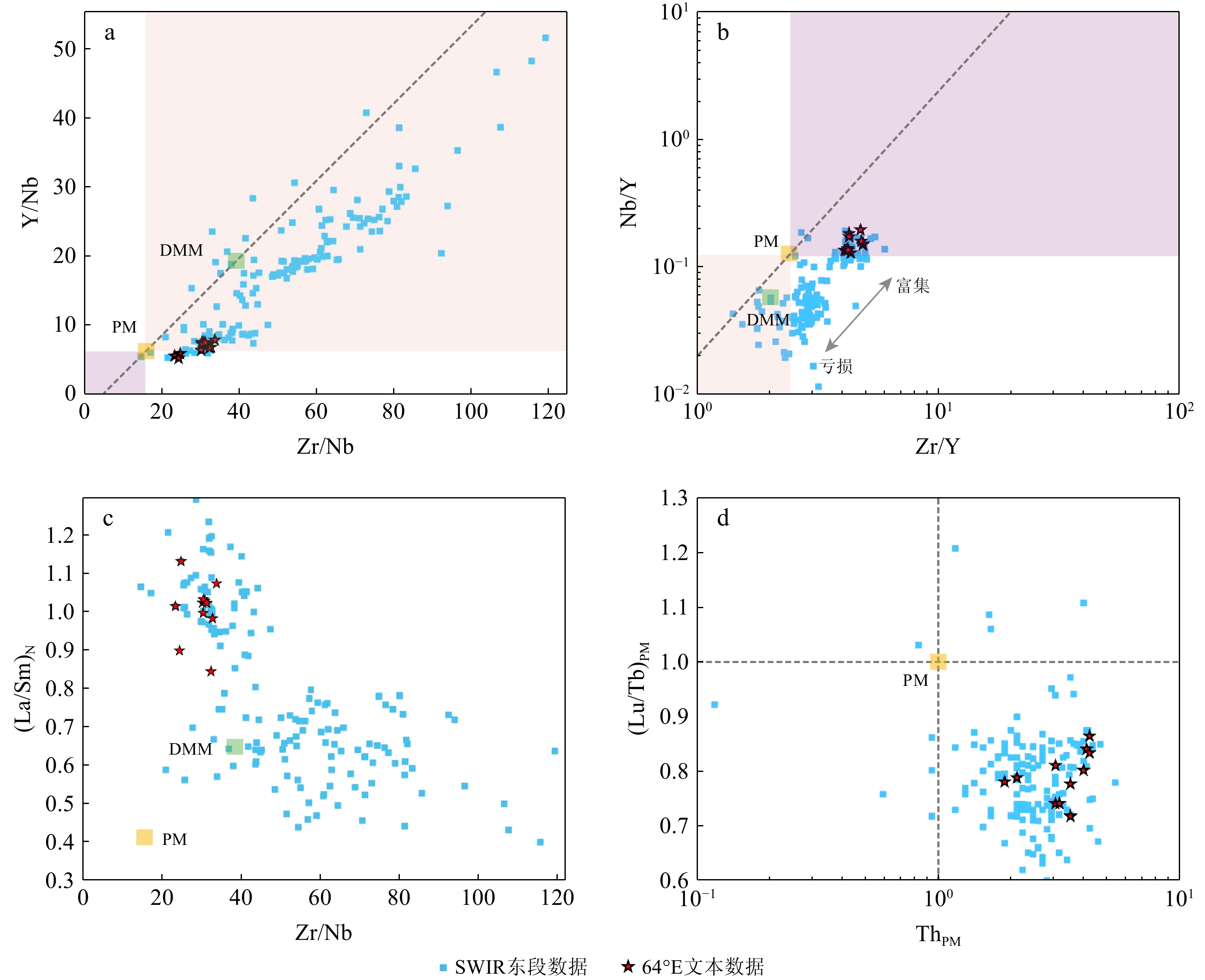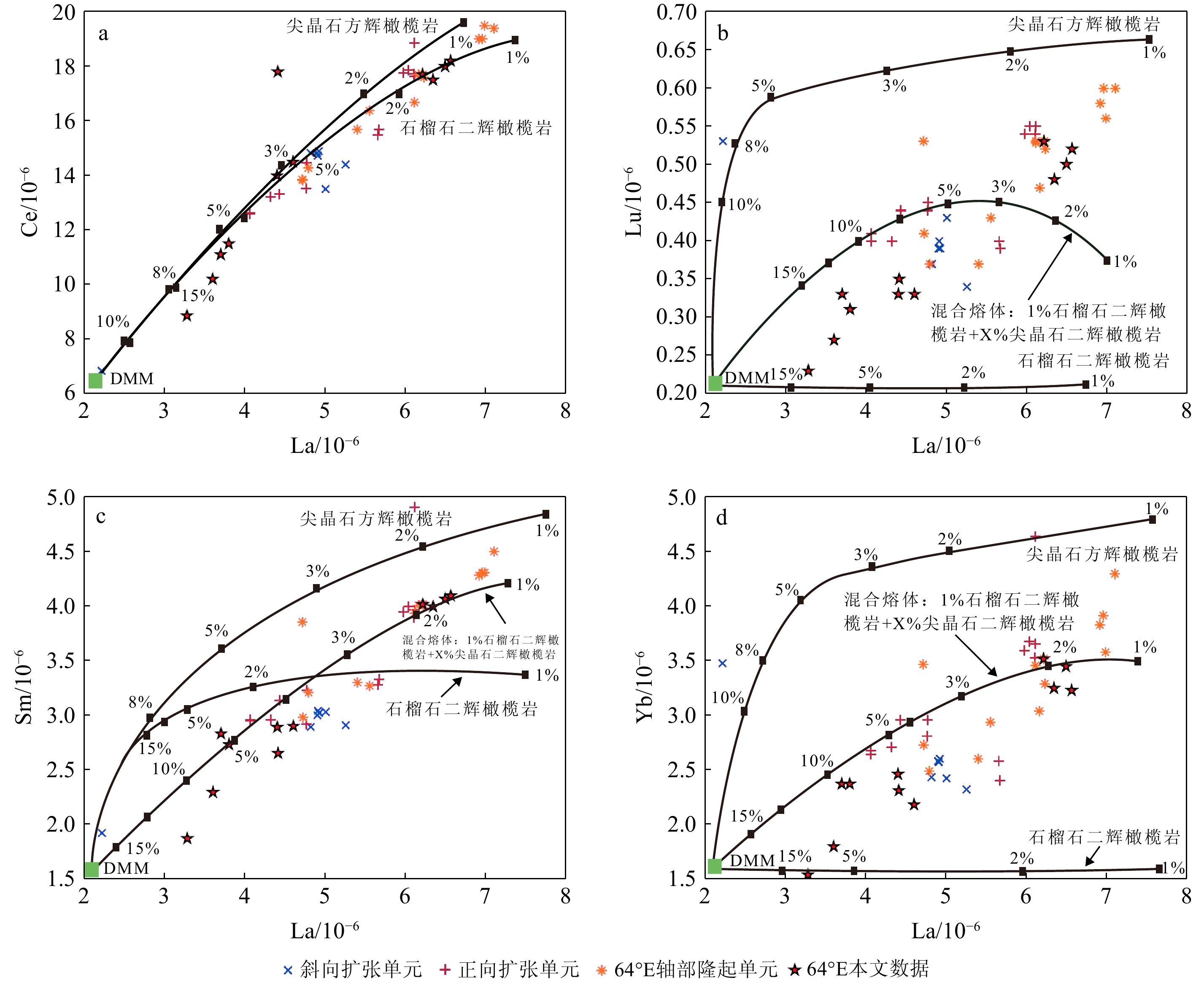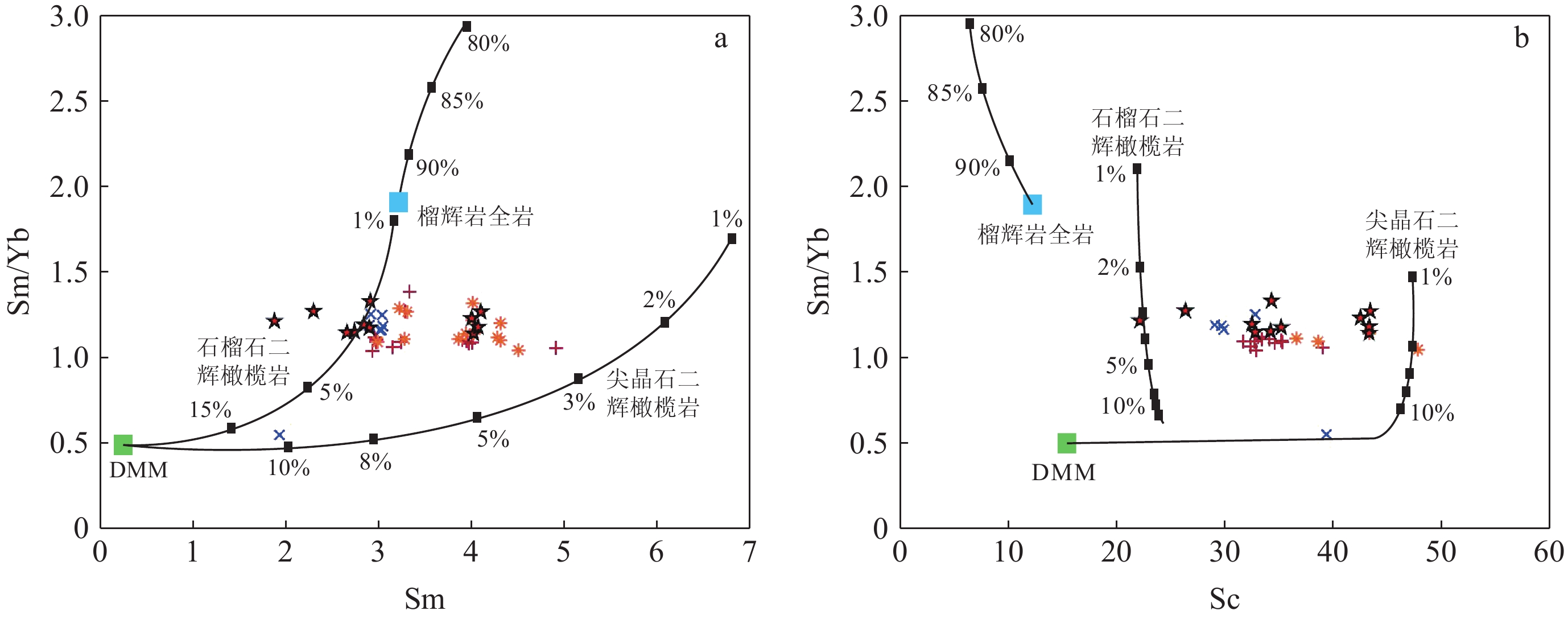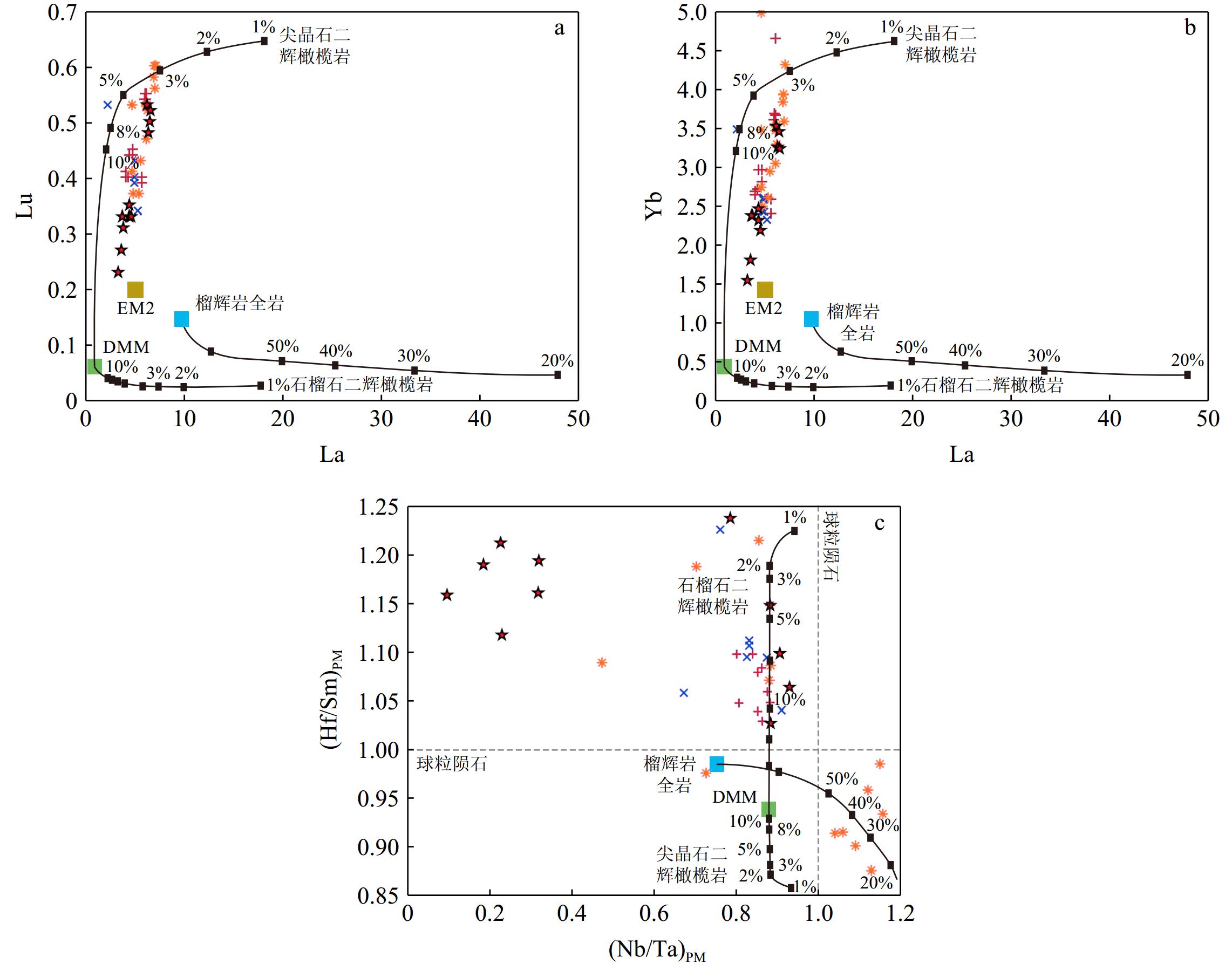MORB trace element geochemistry in the eastern of southwest indian ridge and its indication for the composition of mantle source
-
摘要:
西南印度洋中脊东段(E-SWIR)处于61°~70°E区域,具有相对匮乏的熔体供给。该区产出的大多数洋中脊玄武岩(MORB)具有富集不相容元素以及大离子亲石元素等特征,属典型E-MORB。基于玄武岩样品的微量元素地球化学资料,通过La/Sm、Zr/Nb和Lu/Tb等分析表明E-SWIR地幔具有明显的不均一性,这种不均一性可能与地幔中辉石岩含量的沿轴变化有关。利用稀土元素Ce、Sm、Lu和Yb含量结合部分熔融计算模拟结果,进一步阐明地幔源区中石榴石的作用与影响,并且认为其可能是以含金红石榴辉岩的形式赋存于地幔之中。对E-SWIR地幔源区榴辉岩性质和赋存形式的识别是探讨E-MORB成因、地幔不均一性与洋中脊构造演化等科学问题的关键。
Abstract:The eastern of the southwest Indian ridge (E-SWIR) is located between 61° and 70° E, with relatively low melt supply. Most of the mid-ocean ridge basalts (MORB) produced in this area is a typical E-MORB with the characteristics of enrichment of incompatible elements and large ion lithophile elements. Based on the trace element geochemical data of basalt samples, the analysis of La/Sm, Zr/Nb and Lu/Tb shows that the E-SWIR mantle has obvious heterogeneity, which may be related to the axial variation of pyroxenite content in the mantle. Using the contents of rare earth elements Ce, Sm, Lu and Yb in combination with the simulation results of partial melting calculation, the role and influence of garnet in the mantle source area are further clarified, and it is believed that it may exist in the mantle as auriferous garnet pyroxene. The identification of the nature and occurrence form of eclogites in the E-SWIR mantle source region is the key to discuss the origin of E-MORB, mantle heterogeneity and the tectonic evolution of mid ocean ridge.
-
二辉橄榄岩一直被认为是西南印度洋中脊东段(E-SWIR)地幔岩的重要组成部分,但近些年来越来越多的学者认为E-SWIR地幔源区中可能存在一定数量的辉石岩[1-5]。洋中脊玄武岩(MORB)被认为是地幔物质被动上涌、减压熔融所形成的最终产物,含有辉石岩的地幔岩部分熔融往往形成富集型洋中脊玄武岩(E-MORB)[6-8]。由于地幔潜在温度较低,E-SWIR的岩浆供应量较少[9-11],有利于富集的辉石组分在更难熔的亏损橄榄岩中先发生部分熔融。一个具有不同固相状态的、多组分的、不均一地幔源区会产生复杂的熔融模式,这取决于各组分的部分熔融、均一性和富集程度[12-14]。前人对沿中大西洋中脊的Vema岩石圈剖面提出了类似的过程[7]。此外,部分学者认为西南印度洋中脊(SWIR)和东南印度洋中脊(SEIR)的MORB样品中表现出较低3He/4He同位素组成,是由于受到不同比例辉石衍生熔体(具有极低3He/4He比值)的影响[8,15-16]。
前人基于MORB的地球化学组成提出许多关于示踪辉石岩的岩石学参数,比如Fe/Mn、Zn/Fe、FC3MS以及FCKANTMS等[17-20],这些参数都可以很好地反映岩浆源岩的岩性以及熔融残余的矿物组合。但是辉石岩涵盖了从榴辉岩到含橄榄石的斜方辉石岩等大量岩性变化,所以进一步查明地幔源区岩石类型与组合一直是学者们研究的热点。基于此,本文针对64°E玄武岩样品的微量元素组成以及区域地球化学资料,对地幔源区岩性特征与矿物组合展开详细部分熔融数值模拟研究,以揭示E-SWIR地幔源区中榴辉岩相存在的证据以及对地幔源区的贡献,可为E-SWIR区域E-MORB成因、地幔不均一性的起源以及洋中脊构造演化等提供新的认识。
1. 区域地质背景
西南印度洋中脊东段(E-SWIR),处于Melville转换断层(61°E)以东至罗德里格斯三连点(Rodrigues Triple Junction, RTJ,70°E)之间(图1a),该洋脊段整体扩张方向约为60°(北东—东向),平均全扩张速率小于14 mm/a,洋脊轴基本不发育转换断层,而是受一些规模较小的非转换不连续带(NTDs)影响发生错动(图1b)。相比于Melville转换断层以西洋脊段,E-SWIR具有相对平坦的海底地形且更大的平均水深(约
4730 m),此外还表现出相对较薄的洋壳厚度(通常小于4 km)以及较低的地幔熔融程度等特征,因此,E-SWIR也被认为是整个西南印度洋中脊岩浆作用最匮乏的区域[9-10,21]。![]() 图 1 研究区及采样位置a:西南印度洋中脊水深图, b:西南印度洋中脊东段水深图,c:西南印度洋中脊东段水深剖面图及岩浆构造单元(灰色代表斜向扩张段63°~64°E ,红色代表64°E Jourdanne海山,蓝色代表正向扩张段64°~65°E),d:64°E附近水深图及本文样品位置(改自文献[22])。Figure 1. Location of the study area and samplinga: The geotectonic setting and topography of the Southwest Indian Ridge (SWIR), b: the area between the Melville Fracture Zone and Rodrigues Triple Junction, c: along-axis bathymetric profile between 61°E and 69°E, d: topography of the Tianzuo hydrothermal field and the adjacent Tiancheng and Mt. Jourdanne fields from multibeam sonar data (modified from reference [22]).
图 1 研究区及采样位置a:西南印度洋中脊水深图, b:西南印度洋中脊东段水深图,c:西南印度洋中脊东段水深剖面图及岩浆构造单元(灰色代表斜向扩张段63°~64°E ,红色代表64°E Jourdanne海山,蓝色代表正向扩张段64°~65°E),d:64°E附近水深图及本文样品位置(改自文献[22])。Figure 1. Location of the study area and samplinga: The geotectonic setting and topography of the Southwest Indian Ridge (SWIR), b: the area between the Melville Fracture Zone and Rodrigues Triple Junction, c: along-axis bathymetric profile between 61°E and 69°E, d: topography of the Tianzuo hydrothermal field and the adjacent Tiancheng and Mt. Jourdanne fields from multibeam sonar data (modified from reference [22]).64°E附近发育典型的洋中脊轴部隆起地形,位于#11洋脊段的中部[10-11],又称作为Jourdanne海山,海山顶部距离轴部裂谷约有
1000 m的高度。自西向东依次将63°~65°E区域划分成3个不同构造单元区域,分别是非转换断层不连续带(NTDs,也可以称为斜向扩张单元,63°~63.8°E)、轴部火山隆起区域(63.8°~64°E,Jourdanne海山)、正向扩张区域(64°~64.8°E)。64°E Jourdanne海山是由一系列的挤出构造单元组成,主要以溢流状、片流状以及枕状熔岩交替出现。溢流熔岩主要出现在平缓倾斜山坡的北面一侧,而枕状熔岩以及一些基性岩石碎屑往往出现在海山顶部。前人在E-SWIR地区发现两种类型的MORB(E-MORB和N-MORB)均有不同规模的产出[23],但是相比于西南印度洋中脊Melville转换断层以西区域,E-MORB所占比重明显增加。部分学者还在局部非岩浆增生洋脊段发现有少量超基性岩或蛇纹石化橄榄岩出露,而且在一些离轴区域发现辉长岩等[8,24]。
2. 样品与测试
本研究的MORB样品通过“大洋一号”的DY115-19、DY115-20、DY115-26、DY115-30、DY115-49和“向阳红9号”的DY125-35航次的调查,在西南印度洋中脊27.5°~28°S、63.5°~64°E区域,分别利用TVG电视抓斗和“蛟龙号”载人深潜器作业获取(详见文献[22])。
MORB类型主要为超斑状或斑状玄武岩,少数样品为隐晶质玄武岩,个别样品的气孔较多。样品整体较新鲜,表面由于与海水长期接触,表现为不同程度的蚀变和氧化,形成灰绿色、灰黑色表层或者棕褐色氧化层。少数样品具有明显的冷凝边结构,形成一定厚度的玻璃壳层。手标本中可见斑晶矿物发育较完整,主要以斜长石为主,橄榄石次之。MORB样品的全岩微量元素(含稀土)分析测试仪器为Thermo X Series 2电感耦合等离子体质谱仪(Thermo X Series 2,ICP-MS),实验在中国科学院广州地球化学研究所同位素地球化学国家重点实验室完成,详细分析步骤见文献[25]。
3. 结果
3.1 64°E玄武岩样品的微量与稀土元素组成
本次研究获得的样品微量和稀土元素测试结果见附表1。其中,La含量的变化范围为(3.28~6.56)×10−6,Ni含量为(41.2~93.4)×10−6,Sm含量为(1.87~4.07)×10−6,Yb含量为(1.54~3.52)×10−6。研究区样品的稀土元素总量(∑REE)变化范围为(32.57~67.47)×10−6,其中30I-TVG2-1与30I-TVG2-2玄武岩样品具有非常低的∑REE,分别为37.71×10−6和32.57×10−6。玄武岩样品的(La/Sm)N = 0.79~1.13,(Ce/Yb)N = 1.35~2.14,与典型的E-MORB类似,具有轻稀土富集配分模式。
1 64°E玄武岩样品微量和稀土元素(10−6)测试结果样品 87-S01 87-S02 87-S03 87-S06 19III-TVG03 26VI-TVG02 26VI-TVG03-1 26VI-TVG03-2 30I-TVG2-1 30I-TVG2-2 49I-TVG01-1 Sc 35.2 34.2 32.5 34.3 43.3 42.5 43.3 43.4 26.3 22.1 32.8 V 199 192 185 197 240 236 244 240 147 125 181 Cr 202 205 192 182 152 207 174 174 223 205 263 Co 109.5 232 154.5 99.2 35.1 33.2 34.6 34.2 132 104 33.2 Ni 93 88.5 85.8 84.4 41.2 43.7 41.3 42 58.4 48.8 93.4 Cu 61.5 76.5 60.4 53.5 88.3 82.5 82.8 85 60.5 44.9 65.8 Zn 55 54 51 55 124 68.7 70.6 72.9 42.7 35.3 68.5 Rb 1 0.6 0.5 2.1 2.36 2.16 2.47 2.64 1.42 1.15 1.77 Sr 203 214 225 208 186 195 195 201 271 283 232 Y 24.3 22.6 21.9 24 35.4 33.5 35.1 35.5 18.7 15.7 23.4 Zr 117.5 107 106.5 114.5 144 141 145 149 79.4 66.7 101 Nb 3.6 4.4 3.3 3.8 4.75 4.52 4.72 4.91 3.41 2.7 3 Ba 19.9 20.4 20.1 19.8 26.1 26.9 27 26.5 17.9 16 22.1 Hf 2.4 2.2 2.2 2.4 3.21 2.96 3.11 2.93 1.93 1.51 2.28 Ta 0.65 2.66 0.83 1.19 0.31 0.28 0.3 0.32 0.87 0.49 0.22 Th 0.3 0.3 0.26 0.27 0.35 0.36 0.34 0.36 0.18 0.16 0.26 U 0.12 0.13 0.1 0.1 0.13 0.12 0.12 0.21 0.092 0.064 0.079 La 4.4 3.8 3.7 4.6 6.21 6.34 6.49 6.56 3.6 3.28 4.41 Ce 14 11.5 11.1 14.5 17.7 17.5 18 18.2 10.2 8.85 17.8 Pr 1.93 1.9 1.87 1.87 2.76 2.56 2.59 2.68 1.56 1.35 1.97 Nd 9.4 9.6 9.5 9.3 12.7 12.5 13.3 13.3 7.66 6.62 9.43 Sm 2.89 2.73 2.83 2.9 4.02 4 4.07 4.1 2.29 1.87 2.65 Eu 1.06 1.11 1.14 1.11 1.45 1.36 1.42 1.43 0.9 0.84 1.11 Gd 3.62 3.7 3.4 3.38 5.16 5.13 5.02 5.28 2.72 2.22 3.33 Tb 0.62 0.63 0.65 0.65 0.92 0.81 0.91 0.91 0.5 0.43 0.63 Dy 4.26 4.18 4.01 3.95 6.01 5.45 5.93 5.9 3.34 2.81 4.19 Ho 0.93 0.84 0.89 0.88 1.28 1.17 1.19 1.19 0.68 0.59 0.86 Er 2.37 2.41 2.46 2.41 3.63 3.48 3.6 3.61 1.9 1.7 2.47 Tm 0.36 0.36 0.36 0.37 0.56 0.5 0.54 0.56 0.29 0.24 0.37 Yb 2.46 2.37 2.37 2.18 3.52 3.25 3.45 3.23 1.8 1.54 2.31 Lu 0.33 0.31 0.33 0.33 0.53 0.48 0.5 0.52 0.27 0.23 0.35 Pb − − − − 1.17 1.2 0.99 0.95 2.33 5.48 0.76 ΣREE 48.63 45.44 44.61 48.43 66.45 51.64 59.4 67.47 37.71 32.57 51.88 (La/Sm)N 0.95 0.84 0.81 1.00 0.99 1.02 0.79 1.03 1.01 1.13 1.07 (La/Yb)N 1.32 1.14 1.11 1.34 1.27 1.24 0.97 1.46 1.436 1.53 1.37 (Ce/Yb)N 1.58 1.35 1.30 1.85 1.40 1.50 1.45 1.57 1.57 1.60 2.14 (Sm/Yb)N 1.31 1.28 1.33 1.48 1.27 1.37 1.31 1.41 1.41 1.35 1.27 3.2 E-SWIR玄武岩样品微量与稀土元素沿轴变化
微量和稀土元素与经度的关系图(见附图1和2)可以反映元素沿洋脊轴变化情况。在微量元素含量沿轴变化方面(附图1),研究区的Ni与Cr含量在整个E-SWIR相对较低,而Nb与Sr的含量较高。大多数微量元素沿经度的变化表现出区域性递增或递减,但是Co与Ta含量在E-SWIR基本保持恒定,分别约为47.4×10−6和0.2×10−6。在稀土元素含量沿轴变化方面(附图2),各稀土元素平均含量沿整个E-SWIR的差异较小,只有La和Ce元素含量在RTJ附近相对较小。在研究区东侧正向扩张洋脊段稀土元素(La、Ce、Nd、Tm和Yb)含量表现出自东向西明显的递增变化趋势,而研究区(64°E附近)及其西侧的NTDs之间并没有表现出明显的系统变化趋势。
4. 讨论
4.1 E-SWIR地幔源区性质
E-SWIR洋脊段的MORB样品明显受原始地幔(Primitive Mantle,具有相对富集不相容元素等特点,以下简称PM)和亏损的MORB地幔(Depleted MORB Mantle,具有相对亏损的不相容元素等特点,以下简称DMM)两种不同地幔端元影响(图2a、b),表现出复杂的成分特征,部分MORB样品的(La/Sm)N>0.8(特别是64°E研究区附近MORB样品),具有典型的E-MORB特征(图2c),但同时N-MORB在本区域也几乎有同等规模的发育[8,26],这表明E-SWIR岩石圈地幔组成具有明显不均一性。此外,MORB样品的(Lu/Tb)PM<1,但ThPM>1(图2d),这反映出占主导的、亏损的地幔中混有一定数量的富集组分。最近研究表明,在整个E-SWIR地幔源区中存在一定规模的辉石岩[5]。地幔中辉石岩含量的变化,同时影响了洋中脊不同区段内各种类型MORB的产出。
![]() 图 2 E-SWIR稀土元素比值关系图a:Y/Nb与Zr/Nb关系图,b:Nb/Y与Zr/Y关系图, c:(La/Sm)N与Zr/Nb关系图, d:(Lu/Tb)PM与ThPM关系图。本文以外数据来自PetDB 数据库http://www.petdb.orgFigure 2. The relationship between rare-earth elementsa: Y/Nb and Zr/N, b: Nb/Y and Zr/Y, c:(La/Sm)N and Zr/Nb, d: (Lu/Tb)PM and ThPMData outside of this article are from PetDB, http://www.petdb.org
图 2 E-SWIR稀土元素比值关系图a:Y/Nb与Zr/Nb关系图,b:Nb/Y与Zr/Y关系图, c:(La/Sm)N与Zr/Nb关系图, d:(Lu/Tb)PM与ThPM关系图。本文以外数据来自PetDB 数据库http://www.petdb.orgFigure 2. The relationship between rare-earth elementsa: Y/Nb and Zr/N, b: Nb/Y and Zr/Y, c:(La/Sm)N and Zr/Nb, d: (Lu/Tb)PM and ThPMData outside of this article are from PetDB, http://www.petdb.orgE-SWIR洋脊段MORB样品整体表现出具有较高的(La/Sm)N(平均为0.93)、高的Zr/Nb(20~120)和低的Zr/Y(小于3)、高的Y/Nb(8~54)(图2a-c),而且这些MORB样品还具有较低的(Lu/Tb)PM(基本小于1,图2d),由于石榴石比单斜辉石在Lu/Tb分离方面更有效[27],所以起始部分熔融深度可能位于石榴石相稳定域。研究区64°E附近样品也显示出相似的原始地幔标准化微量元素模式[22],这表明玄武质熔体在上涌过程中受到同化或混染作用的影响并不显著。而且其微量元素组成与前人在E-SWIR区域发现的大多数E-MORB样品极为相似[22,26],这说明它们可能有着共同的地幔源区。
4.2 石榴石特征
石榴石中稀土元素(如Ce、Sm、Lu和Yb等)之间相容性的不同,可以用来识别地幔源区中是否存在石榴石[1,17,24]。我们通过MELT软件对石榴石二辉橄榄岩进行非模式分离熔融模拟(全岩分配系数D据文献[28],石榴石中Sr、Zr和Hf 的分配系数据文献[29],Ti 的分配系数据文献[30]),结果显示出与尖晶石二辉橄榄岩完全不同的熔融曲线(图3)。由于石榴石中Sm、Yb和Lu比La更相容[31-32],所以随着熔融程度的增大表现出平缓到负的趋势,这说明地幔中含石榴石组分发生一定程度的熔融。Lu和Yb在石榴石中是最相容的稀土元素[33-34],所以尖晶石二辉橄榄岩和石榴石二辉橄榄岩熔融曲线之间的分散程度也相对较大(图3b,d)。
![]() 图 3 63°~65°E区域Ce,Lu,Sm和Yb分别与La的关系图图上显示尖晶石方辉橄榄岩与石榴石二辉橄榄岩部分熔融曲线,以及两者混合熔体(1%石榴石二辉橄榄岩+X%尖晶石二辉橄榄岩)。本文以外数据来自PetDB 数据库http://www.petdb.orgFigure 3. The relationship between Ce, Lu, Sm, Yb and La at 63°~65°EPartial melting curves of spinel harzburgite and garnet lherzolite and their mixed melts (1% garnet lherzolite + X% spinel lherzolite). Data outside of this article are from PetDB, http://www.petdb.org
图 3 63°~65°E区域Ce,Lu,Sm和Yb分别与La的关系图图上显示尖晶石方辉橄榄岩与石榴石二辉橄榄岩部分熔融曲线,以及两者混合熔体(1%石榴石二辉橄榄岩+X%尖晶石二辉橄榄岩)。本文以外数据来自PetDB 数据库http://www.petdb.orgFigure 3. The relationship between Ce, Lu, Sm, Yb and La at 63°~65°EPartial melting curves of spinel harzburgite and garnet lherzolite and their mixed melts (1% garnet lherzolite + X% spinel lherzolite). Data outside of this article are from PetDB, http://www.petdb.orgE-SWIR 64°E样品中Ce、Sm、Lu和Yb含量的变化表现出与石榴石二辉橄榄岩低程度部分熔融趋势一致。在石榴石稳定域内发生的部分熔融可能会持续到尖晶石稳定域,因此不同比例熔体的混合可以解释大部分元素含量变化[6]。图3b、c和d中的混合熔体曲线反映了1%熔融程度的石榴石二辉橄榄岩熔体与不同比例(占比逐渐升高)的尖晶石二辉橄榄岩熔体混合的结果。混合熔融曲线(尖晶石二辉橄榄岩部分熔融程度小于15%)基本涵盖所有稀土元素的变化范围,混合有石榴石二辉橄榄岩低程度部分熔融所形成的熔体可以很好地解释E-SWIR 64°E玄武岩样品中La含量升高的原因。
此外,64°E玄武岩样品中Sm与Sc含量在地幔源区多岩相组合的熔融曲线(图4)中表现出十分相似的变化程度,并且Sm/Yb的分离程度相对较小。相对于全球MORB的平均值(通常为1.0~1.1),这些分馏校正后的Sm/Yb范围相对较大[35-37]。一般认为Sm/Yb的升高通常与地幔源区中的残留石榴石有关[38-39],然而一些基于配分系数变化的研究表明,石榴石的分馏并不会产生相对应的REE分布模式[40]。 如图4a所示,石榴石二辉橄榄岩熔融使得Sm/Yb发生明显变化(相较于尖晶石二辉橄榄岩熔融)。64°E玄武岩样品中Sm/Yb的变化范围为1.2~1.4,这表明地幔岩部分熔融过程中需要有石榴石的参与,石榴石二辉橄榄岩1%至5%的部分熔融可以解释64°E玄武岩样品中Sm/Yb升高的原因。部分样品表现出较低的Sm/Yb,这可能是由于石榴石二辉橄榄岩衍生的熔体所占比例相对较小所导致。因此,由不同比例的石榴石和尖晶石二辉橄榄岩衍生熔体的混合基本可以解释大多数64°E玄武岩样品化学组成的变化。
![]() 图 4 63°~65°E区域Sm/Yb与Sm、Sc关系图a:Sm/Yb与Sm关系图,b:Sm/Yb与Sc关系图。图上显示尖晶石二辉橄榄岩、石榴石二辉橄榄岩和榴辉岩部分熔融曲线。图例和数据来源同图3。Figure 4. The relationship of Sm/Yb and Sm, Sm/Yb and Sc at 63°~65°Ea: Sm/Yb and Sm, b: Sm/Yb and Sc. Partial melting curves of spinel harzburgite and garnet lherzolite and their mixed melts are shown in the figure. The legends and data source same as Fig.3
图 4 63°~65°E区域Sm/Yb与Sm、Sc关系图a:Sm/Yb与Sm关系图,b:Sm/Yb与Sc关系图。图上显示尖晶石二辉橄榄岩、石榴石二辉橄榄岩和榴辉岩部分熔融曲线。图例和数据来源同图3。Figure 4. The relationship of Sm/Yb and Sm, Sm/Yb and Sc at 63°~65°Ea: Sm/Yb and Sm, b: Sm/Yb and Sc. Partial melting curves of spinel harzburgite and garnet lherzolite and their mixed melts are shown in the figure. The legends and data source same as Fig.34.3 榴辉岩相
前文中的许多地球化学指标都暗示了地幔中残留石榴石的存在,而且样品中微量元素的变化趋势介于石榴石二辉橄榄岩与尖晶石二辉橄榄岩熔融曲线之间,这说明存在有一定比例的尖晶石二辉橄榄岩熔体的混入。但是地幔岩1%~5%熔融程度所产生的熔体不足以在E-SWIR 64°E附近产生约7 km厚的洋壳[8],而且混有尖晶石二辉橄榄岩熔体的石榴石二辉橄榄岩相部分熔融也不能很好地解释轻稀土元素的极端富集现象[22]。
亏损的地幔橄榄岩熔体与不同程度的榴辉岩熔体混合同样可以产生高Sm/Yb熔体[14,29,41-44]。榴辉岩全岩的Sm/Yb约为1.9,其部分熔融对Sm/Yb的升高是十分显著的[33-34,44]。尽管将熔融程度80%以上的榴辉岩熔体与熔融程度约6%、亏损的橄榄岩熔体混合似乎有些不合理,但根据前人研究表明,E-SWIR的MORB样品中挥发组分的含量普遍较高[5],富含挥发组分榴辉岩的固相线可能比无水橄榄岩深得多。因此,榴辉岩在到达橄榄岩固相线时发生60%以上的熔融是存在一定可能性的[12-13]。
由图4b中Sm/Yb与Sc含量的关系可知,尖晶石二辉橄榄岩熔融并不能解释Sm/Yb升高与Sc含量降低之间的负相关关系,而石榴石二辉橄榄岩的低程度部分熔融可以在64°E与NTDs玄武岩样品之间产生一系列变化。尽管石榴石二辉橄榄岩熔融程度在1%到10%之间的熔融曲线具有基本恒定的Sc含量和变化的Sm/Yb,但趋势还是略微延伸至低于石榴石二辉橄榄岩Sc含量的方向。64°E轴部隆起单元中MORB样品的Sc含量和Sm/Yb的关系,同样在南大西洋中脊的MORB样品中有所体现[1],但其Sm/Yb值更高,Sc含量更低。Roux等[1]认为这可能是由于局部构造作用影响熔融过程的结果,部分辉石岩优先发生熔融并最终占熔体的20%~40%。榴辉岩部分熔融曲线表明(图4),64°E轴部隆起单元的地幔很大可能混有一些低Sc含量和高Sm/Yb的物质参与到整个熔融过程当中。
如图3所示,64°E玄武岩样品中La含量(最高约为7.04×10−6)高于尖晶石二辉橄榄岩或石榴石二辉橄榄岩5%部分熔融时的La含量,但明显低于其他地幔端元中的La含量(比如EM2端元的La含量约为16×10−6)。图5a和图5b显示了64°E玄武岩样品中Lu、Yb与La的关系以及榴辉岩的熔融趋势。三个岩浆构造单元中MORB样品数据变化基本与榴辉岩至少约50%熔融程度的熔融曲线相吻合,但是大部分数据位于一个相当窄的变化范围内,这反映出亏损的橄榄岩熔体与榴辉岩熔体以不同比例混合的结果。
![]() 图 5 63°~65°E区域稀土元素关系图a:Lu与La关系图,b:Yb与La关系图,c:(Hf/Sm)PM与(Nb/Ta)PM关系图。图上显示尖晶石二辉橄榄岩、石榴石二辉橄榄岩和榴辉岩部分熔融曲线。图例和数据来源同图3。Figure 5. The relationship of Lu and La, Yb and La, (Hf/Sm)PM and (Nb/Ta)PM at 63°~65°Ea: Lu and La, b: Yb and La, c: (Hf/Sm)PM and (Nb/Ta)PM. Partial melting curves of spinel harzburgite and garnet lherzolite and their mixed melts are shown in the figure. The legends and data source same as Fig.3
图 5 63°~65°E区域稀土元素关系图a:Lu与La关系图,b:Yb与La关系图,c:(Hf/Sm)PM与(Nb/Ta)PM关系图。图上显示尖晶石二辉橄榄岩、石榴石二辉橄榄岩和榴辉岩部分熔融曲线。图例和数据来源同图3。Figure 5. The relationship of Lu and La, Yb and La, (Hf/Sm)PM and (Nb/Ta)PM at 63°~65°Ea: Lu and La, b: Yb and La, c: (Hf/Sm)PM and (Nb/Ta)PM. Partial melting curves of spinel harzburgite and garnet lherzolite and their mixed melts are shown in the figure. The legends and data source same as Fig.364°E轴部隆起单元MORB样品的(Nb/Ta)N>1,而相邻构造单元玄武岩样品的(Nb/Ta)N<1[22],这表明源岩中的榴辉岩可能还含有少量金红石[45-46]。含金红石榴辉岩中的Zr和Hf相对于Sm和Eu比较亏损。图5c表示的是样品中(Hf/Sm)PM与(Nb/Ta)PM之间关系,其中还包括有尖晶石二辉橄榄岩、石榴石二辉橄榄岩和含金红石榴辉岩三种岩性的熔融曲线。绝大多数玄武岩样品表现出超球粒陨石的(Hf/Sm)PM和亚球粒陨石的(Nb/Ta)PM的特征,但64°E玄武岩样品表现出复杂变化的特征,部分前人数据具有亚球粒陨石的(Hf/Sm)PM值和超球粒陨石的(Nb/Ta)PM值,而本文数据则表现出超球粒陨石的(Hf/Sm)PM值和亚球粒陨石的(Nb/Ta)PM值,这反映出地幔不均一性在很小的尺度范围内也有显著的表现。部分样品表现出(Nb/Ta)N>1和亏损(Hf/Sm)PM的特征与榴辉岩岩性基本一致,而且尖晶石和石榴石二辉橄榄岩的熔融曲线并不能解释(Nb/Ta)PM值的富集现象,但含金红石榴辉岩的部分熔融可以很好地解释超球粒陨石的(Nb/Ta)PM值,也可以解释La含量的增加以及LREE和HREE之间的负相关关系。因此,推测在E-SWIR地幔源区存在含金红石的榴辉岩,它对整个区域内不同类型MORB化学组成变化产生了一系列的影响。
5. 结论
(1)样品中微量元素La/Sm、Zr/Nb和Lu/Tb等表现出富集和(或)亏损的特征,表明E-SWIR地幔具有明显的不均一性,可能与源区中存在辉石岩有关。地幔中辉石岩含量沿洋中脊走向上的变化,导致E-SWIR区域不同类型MORB的产出。
(2)通过Ce、Sm、Lu和Yb等稀土元素在石榴石中相容性的差异,结合部分熔融计算模拟结果,E-SWIR地幔源区中存在一定数量的石榴石,而且其赋存状态可能是以含金红石榴辉岩而不是石榴石二辉橄榄岩的形式存在于地幔之中。
注:附表、附图见 http://jhydz.com.cn/article/doi/10.16562/j.cnki.0256-1492.2021121501
-
图 1 研究区及采样位置
a:西南印度洋中脊水深图, b:西南印度洋中脊东段水深图,c:西南印度洋中脊东段水深剖面图及岩浆构造单元(灰色代表斜向扩张段63°~64°E ,红色代表64°E Jourdanne海山,蓝色代表正向扩张段64°~65°E),d:64°E附近水深图及本文样品位置(改自文献[22])。
Figure 1. Location of the study area and sampling
a: The geotectonic setting and topography of the Southwest Indian Ridge (SWIR), b: the area between the Melville Fracture Zone and Rodrigues Triple Junction, c: along-axis bathymetric profile between 61°E and 69°E, d: topography of the Tianzuo hydrothermal field and the adjacent Tiancheng and Mt. Jourdanne fields from multibeam sonar data (modified from reference [22]).
图 2 E-SWIR稀土元素比值关系图
a:Y/Nb与Zr/Nb关系图,b:Nb/Y与Zr/Y关系图, c:(La/Sm)N与Zr/Nb关系图, d:(Lu/Tb)PM与ThPM关系图。本文以外数据来自PetDB 数据库http://www.petdb.org
Figure 2. The relationship between rare-earth elements
a: Y/Nb and Zr/N, b: Nb/Y and Zr/Y, c:(La/Sm)N and Zr/Nb, d: (Lu/Tb)PM and ThPMData outside of this article are from PetDB, http://www.petdb.org
图 3 63°~65°E区域Ce,Lu,Sm和Yb分别与La的关系图
图上显示尖晶石方辉橄榄岩与石榴石二辉橄榄岩部分熔融曲线,以及两者混合熔体(1%石榴石二辉橄榄岩+X%尖晶石二辉橄榄岩)。本文以外数据来自PetDB 数据库http://www.petdb.org
Figure 3. The relationship between Ce, Lu, Sm, Yb and La at 63°~65°E
Partial melting curves of spinel harzburgite and garnet lherzolite and their mixed melts (1% garnet lherzolite + X% spinel lherzolite). Data outside of this article are from PetDB, http://www.petdb.org
图 4 63°~65°E区域Sm/Yb与Sm、Sc关系图
a:Sm/Yb与Sm关系图,b:Sm/Yb与Sc关系图。图上显示尖晶石二辉橄榄岩、石榴石二辉橄榄岩和榴辉岩部分熔融曲线。图例和数据来源同图3。
Figure 4. The relationship of Sm/Yb and Sm, Sm/Yb and Sc at 63°~65°E
a: Sm/Yb and Sm, b: Sm/Yb and Sc. Partial melting curves of spinel harzburgite and garnet lherzolite and their mixed melts are shown in the figure. The legends and data source same as Fig.3
图 5 63°~65°E区域稀土元素关系图
a:Lu与La关系图,b:Yb与La关系图,c:(Hf/Sm)PM与(Nb/Ta)PM关系图。图上显示尖晶石二辉橄榄岩、石榴石二辉橄榄岩和榴辉岩部分熔融曲线。图例和数据来源同图3。
Figure 5. The relationship of Lu and La, Yb and La, (Hf/Sm)PM and (Nb/Ta)PM at 63°~65°E
a: Lu and La, b: Yb and La, c: (Hf/Sm)PM and (Nb/Ta)PM. Partial melting curves of spinel harzburgite and garnet lherzolite and their mixed melts are shown in the figure. The legends and data source same as Fig.3
1 64°E玄武岩样品微量和稀土元素(10−6)测试结果
样品 87-S01 87-S02 87-S03 87-S06 19III-TVG03 26VI-TVG02 26VI-TVG03-1 26VI-TVG03-2 30I-TVG2-1 30I-TVG2-2 49I-TVG01-1 Sc 35.2 34.2 32.5 34.3 43.3 42.5 43.3 43.4 26.3 22.1 32.8 V 199 192 185 197 240 236 244 240 147 125 181 Cr 202 205 192 182 152 207 174 174 223 205 263 Co 109.5 232 154.5 99.2 35.1 33.2 34.6 34.2 132 104 33.2 Ni 93 88.5 85.8 84.4 41.2 43.7 41.3 42 58.4 48.8 93.4 Cu 61.5 76.5 60.4 53.5 88.3 82.5 82.8 85 60.5 44.9 65.8 Zn 55 54 51 55 124 68.7 70.6 72.9 42.7 35.3 68.5 Rb 1 0.6 0.5 2.1 2.36 2.16 2.47 2.64 1.42 1.15 1.77 Sr 203 214 225 208 186 195 195 201 271 283 232 Y 24.3 22.6 21.9 24 35.4 33.5 35.1 35.5 18.7 15.7 23.4 Zr 117.5 107 106.5 114.5 144 141 145 149 79.4 66.7 101 Nb 3.6 4.4 3.3 3.8 4.75 4.52 4.72 4.91 3.41 2.7 3 Ba 19.9 20.4 20.1 19.8 26.1 26.9 27 26.5 17.9 16 22.1 Hf 2.4 2.2 2.2 2.4 3.21 2.96 3.11 2.93 1.93 1.51 2.28 Ta 0.65 2.66 0.83 1.19 0.31 0.28 0.3 0.32 0.87 0.49 0.22 Th 0.3 0.3 0.26 0.27 0.35 0.36 0.34 0.36 0.18 0.16 0.26 U 0.12 0.13 0.1 0.1 0.13 0.12 0.12 0.21 0.092 0.064 0.079 La 4.4 3.8 3.7 4.6 6.21 6.34 6.49 6.56 3.6 3.28 4.41 Ce 14 11.5 11.1 14.5 17.7 17.5 18 18.2 10.2 8.85 17.8 Pr 1.93 1.9 1.87 1.87 2.76 2.56 2.59 2.68 1.56 1.35 1.97 Nd 9.4 9.6 9.5 9.3 12.7 12.5 13.3 13.3 7.66 6.62 9.43 Sm 2.89 2.73 2.83 2.9 4.02 4 4.07 4.1 2.29 1.87 2.65 Eu 1.06 1.11 1.14 1.11 1.45 1.36 1.42 1.43 0.9 0.84 1.11 Gd 3.62 3.7 3.4 3.38 5.16 5.13 5.02 5.28 2.72 2.22 3.33 Tb 0.62 0.63 0.65 0.65 0.92 0.81 0.91 0.91 0.5 0.43 0.63 Dy 4.26 4.18 4.01 3.95 6.01 5.45 5.93 5.9 3.34 2.81 4.19 Ho 0.93 0.84 0.89 0.88 1.28 1.17 1.19 1.19 0.68 0.59 0.86 Er 2.37 2.41 2.46 2.41 3.63 3.48 3.6 3.61 1.9 1.7 2.47 Tm 0.36 0.36 0.36 0.37 0.56 0.5 0.54 0.56 0.29 0.24 0.37 Yb 2.46 2.37 2.37 2.18 3.52 3.25 3.45 3.23 1.8 1.54 2.31 Lu 0.33 0.31 0.33 0.33 0.53 0.48 0.5 0.52 0.27 0.23 0.35 Pb − − − − 1.17 1.2 0.99 0.95 2.33 5.48 0.76 ΣREE 48.63 45.44 44.61 48.43 66.45 51.64 59.4 67.47 37.71 32.57 51.88 (La/Sm)N 0.95 0.84 0.81 1.00 0.99 1.02 0.79 1.03 1.01 1.13 1.07 (La/Yb)N 1.32 1.14 1.11 1.34 1.27 1.24 0.97 1.46 1.436 1.53 1.37 (Ce/Yb)N 1.58 1.35 1.30 1.85 1.40 1.50 1.45 1.57 1.57 1.60 2.14 (Sm/Yb)N 1.31 1.28 1.33 1.48 1.27 1.37 1.31 1.41 1.41 1.35 1.27 -
[1] Le Roux P J, Le Roex A P, Schilling J G, et al. Mantle heterogeneity beneath the southern Mid-Atlantic Ridge: trace element evidence for contamination of ambient asthenospheric mantle[J]. Earth and Planetary Science Letters, 2002, 203(1):479-498. doi: 10.1016/S0012-821X(02)00832-4
[2] Sobolev A V, Hofmann A W, Kuzmin D V, et al. The amount of recycled crust in sources of mantle-derived melts[J]. Science, 2007, 316(5823):412-417. doi: 10.1126/science.1138113
[3] Zhang G L, Zong C L, Yin X B, et al. Geochemical constraints on a mixed pyroxenite-peridotite source for east Pacific Rise basalts[J]. Chemical Geology, 2012, 330-331:176-187. doi: 10.1016/j.chemgeo.2012.08.033
[4] Lambart S, Laporte D, Schiano P. Markers of the pyroxenite contribution in the major-element compositions of oceanic basalts: review of the experimental constraints[J]. Lithos, 2013, 160-161:14-36. doi: 10.1016/j.lithos.2012.11.018
[5] Paquet M, Hamelin C, Moreira M, et al. The isotopic (He, Ne, Sr, Nd, Hf, Pb) signature in the Indian mantle over 8.8 Ma[J]. Chemical Geology, 2020, 550:119741. doi: 10.1016/j.chemgeo.2020.119741
[6] Brunelli D, Paganelli E, Seyler M. Percolation of enriched melts during incremental open-system melting in the spinel field: a REE approach to abyssal peridotites from the southwest Indian Ridge[J]. Geochimica et Cosmochimica Acta, 2014, 127:190-203. doi: 10.1016/j.gca.2013.11.040
[7] Brunelli D, Cipriani A, Bonatti E. Thermal effects of pyroxenites on mantle melting below mid-ocean ridges[J]. Nature Geoscience, 2018, 11(7):520-525. doi: 10.1038/s41561-018-0139-z
[8] Paquet M, Cannat M, Brunelli D, et al. Effect of melt/mantle interactions on MORB chemistry at the easternmost southwest Indian Ridge (61◦–67◦ E)[J]. Geochemistry, Geophysics, Geosystems, 2016, 17(11):4605-4640. doi: 10.1002/2016GC006385
[9] Muller M R, Minshull T A, White R S. Segmentation and melt supply at the southwest Indian Ridge[J]. Geology, 1999, 27(10):867-870. doi: 10.1130/0091-7613(1999)027<0867:SAMSAT>2.3.CO;2
[10] Cannat M, Rommevaux-Jestin C, Sauter D, et al. Formation of the axial relief at the very slow spreading southwest Indian Ridge (49° to 69°E)[J]. Journal of Geophysical Research:Solid Earth, 1999, 104(B10):22825-22843. doi: 10.1029/1999JB900195
[11] Cannat M, Rommevaux-Jestin C, Fujimoto H. Melt supply variations to a magma-poor ultra-slow spreading ridge (southwest Indian Ridge 61° to 69°E)[J]. Geochemistry, Geophysics, Geosystems, 2003, 4(8):9104.
[12] Pertermann M, Hirschmann M M. Partial melting experiments on a MORB-like pyroxenite between 2 and 3 GPa: constraints on the presence of pyroxenite in basalt source regions from solidus location and melting rate[J]. Journal of Geophysical Research:Solid Earth, 2003, 108(B2):2125.
[13] Pertermann M, Hirschmann M M. Anhydrous partial melting experiments on MORB-like eclogite: phase relations, phase compositions and mineral–melt partitioning of major elements at 2-3 GPa[J]. Journal of Petrology, 2003, 44(12):2173-2201. doi: 10.1093/petrology/egg074
[14] Ito G, Mahoney J J. Flow and melting of a heterogeneous mantle: 1. Method and importance to the geochemistry of ocean island and mid-ocean ridge basalts[J]. Earth and Planetary Science Letters, 2005, 230(1-2):29-46. doi: 10.1016/j.jpgl.2004.10.035
[15] Georgen J E, Kurz M D, Dick H J B, et al. Low 3He/4He ratios in basalt glasses from the western southwest Indian Ridge (10°-24°E)[J]. Earth and Planetary Science Letters, 2003, 206(3-4):509-528. doi: 10.1016/S0012-821X(02)01106-8
[16] Graham D W, Jenkins W J, Schilling J G, et al. Helium isotope geochemistry of mid-ocean ridge basalts from the south Atlantic[J]. Earth and Planetary Science Letters, 1992, 110(1-4):133-147. doi: 10.1016/0012-821X(92)90044-V
[17] Yang Z F, Li J, Liang W F, et al. On the chemical markers of pyroxenite contributions in continental basalts in Eastern China: implications for source lithology and the origin of basalts[J]. Earth-Science Reviews, 2016, 157:18-31. doi: 10.1016/j.earscirev.2016.04.001
[18] Yang Z F, Li J, Jiang Q B, et al. Using major element logratios to recognize compositional patterns of basalt: implications for source lithological and compositional heterogeneities[J]. Journal of Geophysical Research:Solid Earth, 2019, 124(4):3458-3490. doi: 10.1029/2018JB016145
[19] Le Roux V, Lee C T A, Turner S J. Zn/Fe systematics in mafic and ultramafic systems: implications for detecting major element heterogeneities in the earth’s mantle[J]. Geochimica et Cosmochimica Acta, 2010, 74(9):2779-2796. doi: 10.1016/j.gca.2010.02.004
[20] Le Roux V, Dasgupta R, Lee C T A. Mineralogical heterogeneities in the Earth’s mantle: constraints from Mn, Co, Ni and Zn partitioning during partial melting[J]. Earth and Planetary Science Letters, 2011, 307(3-4):395-408. doi: 10.1016/j.jpgl.2011.05.014
[21] Sauter D, Cannat M, Rouméjon S, et al. Continuous exhumation of mantle-derived rocks at the southwest Indian Ridge for 11 million years[J]. Nature Geoscience, 2013, 6(4):314-320. doi: 10.1038/ngeo1771
[22] Dong Z, Tao C H, Liang J, et al. Geochemistry of basalts from southwest Indian Ridge 64°E: implications for the mantle heterogeneity east of the Melville transform[J]. Minerals, 2021, 11(2):175. doi: 10.3390/min11020175
[23] Zhou H Y, Dick H J B. Thin crust as evidence for depleted mantle supporting the Marion Rise[J]. Nature, 2013, 494(7436):195-200. doi: 10.1038/nature11842
[24] Seyler M, Brunelli D, Toplis M J, et al. Multiscale chemical heterogeneities beneath the eastern southwest Indian Ridge (52°E-68°E): trace element compositions of along-axis dredged peridotites[J]. Geochemistry, Geophysics, Geosystems, 2011, 12(9):Q0AC15. doi: 10.1029/2011GC003585
[25] 李献华, 刘颖, 涂湘林, 等. 硅酸盐岩石化学组成的ICP-AES和ICP-MS准确测定: 酸溶与碱熔分解样品方法的对比[J]. 地球化学, 2002, 31(3):289-294 LI Xianhua, LIU Ying, TU Xianglin, et al. Precise determination of chemical compositions in silicate rocks using ICP-AES and ICP-MS: a comparative study of sample digestion techniques of alkali fusion and acid dissolution[J]. Geochimica, 2002, 31(3):289-294.]
[26] Meyzen C M, Toplis M J, Humler E, et al. A discontinuity in mantle composition beneath the southwest Indian Ridge[J]. Nature, 2003, 421(6924):731-733. doi: 10.1038/nature01424
[27] Frey F A, Silva I G N, Huang S C, et al. Depleted components in the source of hotspot magmas: evidence from the Ninetyeast Ridge (Kerguelen)[J]. Earth and Planetary Science Letters, 2015, 426:293-304. doi: 10.1016/j.jpgl.2015.06.005
[28] Kelemen P B, Yogodzinski G M, Scholl D W. Along-strike variation in the Aleutian island arc: genesis of high Mg# andesite and implications for continental crust[M]//Eiler J. Inside the Subduction Factory. Washington: AGU, 2003: 223-276.
[29] Donnelly K E, Goldstein S L, Langmuir C H, et al. Origin of enriched ocean ridge basalts and implications for mantle dynamics[J]. Earth and Planetary Science Letters, 2004, 226(3-4):347-366. doi: 10.1016/j.jpgl.2004.07.019
[30] Cushman B, Sinton J, Ito G, et al. Glass compositions, plume-ridge interaction, and hydrous melting along the Galapagos spreading center, 90.5°W to 98°W[J]. Geochemistry, Geophysics, Geosystems, 2013, 5(8):Q08E17.
[31] 高山, 章军锋, 许文良, 等. 拆沉作用与华北克拉通破坏[J]. 科学通报, 2009, 54(14): 1962-1973 GAO Shan, ZHANG Junfeng, XU Wenliang, et al. Delamination and destruction of the North China Craton[J]. Chinese Science Bulletin, 2009, 54(19): 3367-3378.]
[32] 魏春景, 郑永飞. 大洋俯冲带变质作用、流体行为与岩浆作用[J]. 中国科学: 地球科学, 2020, 50(1): 1-27 WEI Chunjing, ZHENG Yongfei. Metamorphism, fluid behavior and magmatism in oceanic subduction zones[J]. Science China Earth Sciences, 2020, 63(1): 52-77.]
[33] 刘帅奇, 张贵宾. 榴辉岩部分熔融过程中的同位素分馏[J]. 岩石学报, 2021, 37(1): 95-112 LIU Shuaiqi, ZHANG Guibin. Isotope fractionation during partial melting of eclogite[J]. Acta Petrologica Sinica, 37(1): 95-112.]
[34] 王超, 金振民, 高山, 等. 华北克拉通岩石圈破坏的榴辉岩熔体-橄榄岩反应机制: 实验约束[J]. 中国科学: 地球科学, 2010, 40(5): 541-555 WANG Chao, JIN Zhenmin, GAO Shan, et al. Eclogite-melt/peridotite reaction: experimental constrains on the destruction mechanism of the North China Craton[J]. Science China Earth Sciences, 2010, 53(6): 797-809.]
[35] Hofmann A W. Chemical differentiation of the Earth: the relationship between mantle, continental crust, and oceanic crust[J]. Earth and Planetary Science Letters, 1988, 90(3):297-314. doi: 10.1016/0012-821X(88)90132-X
[36] Shen Y, Forsyth D W. Geochemical constraints on initial and final depths of melting beneath mid-ocean ridges[J]. Journal of Geophysical Research:Solid Earth, 1995, 100(B2):2211-2237. doi: 10.1029/94JB02768
[37] White R S, McKenzie D, O'Nions R K. Oceanic crustal thickness from seismic measurements and rare earth element inversions[J]. Journal of Geophysical Research:Solid Earth, 1992, 97(B13):19683-19715. doi: 10.1029/92JB01749
[38] Bender J F, Langmuir C H, Hanson G N. Petrogenesis of basalt glasses from the Tamayo Region, east Pacific Rise[J]. Journal of Petrology, 1984, 25(1):213-254. doi: 10.1093/petrology/25.1.213
[39] Frey F A, Walker N, Stakes D, et al. Geochemical characteristics of basaltic glasses from the AMAR and FAMOUS axial valleys, Mid-Atlantic Ridge (36°-37°N): petrogenetic implications[J]. Earth and Planetary Science Letters, 1993, 115(1-4):117-136. doi: 10.1016/0012-821X(93)90217-W
[40] Blundy J D, Robinson J A C, Wood B J. Heavy REE are compatible in clinopyroxene on the spinel lherzolite solidus[J]. Earth and Planetary Science Letters, 1998, 160(3-4):493-504. doi: 10.1016/S0012-821X(98)00106-X
[41] Hirschmann M M, Stolper E M. A possible role for garnet pyroxenite in the origin of the "garnet signature" in MORB[J]. Contributions to Mineralogy and Petrology, 1996, 124(2):185-208. doi: 10.1007/s004100050184
[42] Hirschmann M M, Kogiso T, Baker M B, et al. Alkalic magmas generated by partial melting of garnet pyroxenite[J]. Geology, 2003, 31(6):481-484. doi: 10.1130/0091-7613(2003)031<0481:AMGBPM>2.0.CO;2
[43] Stracke A, Salters V J M, Sims K W W. Assessing the presence of garnet-pyroxenite in the mantle sources of basalts through combined hafnium-neodymium-thorium isotope systematics[J]. Geochemistry, Geophysics, Geosystems, 2013, 1(12):1006.
[44] Gaffney A M, Nelson B K, Blichert-Toft J. Melting in the Hawaiian plume at 1-2 Ma as recorded at Maui Nui: the role of eclogite, peridotite, and source mixing[J]. Geochemistry, Geophysics, Geosystems, 2005, 6(10):Q10L11.
[45] 陈振宇, 王登红, 陈毓川, 等. 榴辉岩中金红石的矿物地球化学研究及其意义[J]. 地球科学:中国地质大学学报, 2006, 31(4):533-538,550 CHEN Zhenyu, WANG Denghong, CHEN Yuchuan, et al. Mineral geochemistry of rutile in eclogite and its implications[J]. Earth Science:Journal of China University of Geosciences, 2006, 31(4):533-538,550.]
[46] 梁金龙, 施泽明, 徐进勇, 等. 金红石榴辉岩: 一个可能的超球粒陨石Nb/Ta储库[J]. 地球科学进展, 2012, 27(10):1094-1099 LIANG Jinlong, SHI Zeming, XU Jinyong, et al. Rutile-bearing eclogite: one of the possible reservoirs balancing the Nb-depleted silicate Earth[J]. Advances in Earth Science, 2012, 27(10):1094-1099.]




 下载:
下载:








